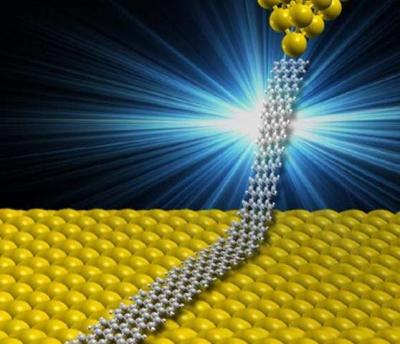Researchers led by the CNR-Nanoscience Institute in Modena, Italy, and the University of Strasbourg in France, have experimentally observed light emission from individual graphene nanoribbons for the first time. They demonstrated that 7-atom-wide nanoribbons emit light at a high intensity that is comparable to bright light-emitting devices made from carbon nanotubes, and that the color can be tuned by adjusting the voltage. These findings may open the door to the development of bright graphene-based light sources.

Experimentally, there have been only a few demonstrations of light emission from graphene nanoribbons, and these have been limited to ensembles of nanoribbons and revealed only weak light emission. So the results of the new study, which show a much brighter light emitted by individual graphene nanoribbons compared to ensembles, hint at the exciting potential of graphene's optical properties.
Tests showed that the individual graphene nanoribbons exhibit an intense optical emission of up to 10 million photons per second, which is 100 times more intense than the emission measured for previous single-molecular optoelectronic devices.
In addition, the researchers found that the energy shift of the main peak changes as a function of the voltage, which provides a way to tune the color of the light. These observations also offer insight into the underlying mechanisms of the light emission from individual graphene nanoribbons, which the researchers plan to further investigate in the future.
"We likely will explore the influence of the width of the graphene nanoribbons on the color of the emitted light, as the width is expected to control the size of the gap," the researchers said. "The impact of defects should also be explored. Eventually, one should propose methods to integrate our graphene nanoribbons devices in larger circuitry."

